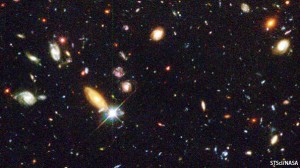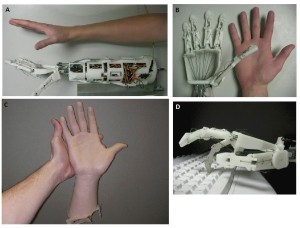There was a paper published recently in the Physical Review Letters that is making some very bold and mind-bending claims: That the idea that the laws of physics do not change with time or distance, one of the cornerstones of modern physics, may not be true after all!
A team led by John Webb and Julian King from the University of New South Wales in Australia present evidence that the fine-structure constant known as alpha may not actually be constant after all. Alpha measures the strength of the electromagnetic force. If it were a mere 4% bigger or smaller than it is, stars would not be able to sustain the nuclear reactions that synthesise carbon and oxygen. One consequence would be that squishy, carbon-based life would not exist.
It seems that alpha varies from place to place within the universe. If their results hold up to the scrutiny, and can be replicated, they will have profound implications—for they suggest that the universe stretches far beyond what telescopes can observe, and that the laws of physics vary within it. Instead of the whole universe being fine-tuned for life, then, humanity finds itself in a corner of space where, Goldilocks-like, the values of the fundamental constants happen to be just right for it.
Slightly belying its name, the fine-structure constant is actually a compound of several other physical constants, whose values can be found in any physics textbook. You start with the square of an electron’s charge, divide it by the speed of light and Planck’s constant, then multiply the whole lot by two pi. The point of this convoluted procedure is that this combination of multiplication and division produces a pure, dimensionless number. The units in which the original measurements were made cancel each other out and the result is 1/137.036, regardless of the measuring system you used in the first place.
Despite its convoluted origin, though, alpha has a real meaning. It characterises the strength of the force between electrically charged particles. As such, it governs—among other things—the energy levels of an atom formed from negatively charged electrons and a positive nucleus. When electrons jump between these energy levels, they absorb and emit light of particular frequencies. These frequencies show up as lines (dark for absorption; bright for emission) in a spectrum. When many different energy levels are involved, as they are in the spectrum of a chemically mixed star, the result is a fine, comb-like structure—hence the constant’s name. If it were to take on a different value, the wavelengths of these lines would change. And that is what Dr Webb and Mr King think they have found.
The light in question comes not from individual stars but from quasars. These are extremely luminous (and distant) galaxies whose energy output is powered by massive black holes at their centres. As light from a quasar travels through space, it passes through clouds of gas that imprint absorption lines onto its spectrum. By measuring the wavelengths of a large collection of these absorption lines and subtracting the effects of the expansion of the universe, the team led by Dr Webb and Mr King was able to measure the value of alpha in places billions of light-years away.
Dr Webb first conducted such a study almost a decade ago, using 76 quasars observed with the Keck telescope in Hawaii. He found that, the farther out he looked, the smaller alpha seemed to be. In astronomy, of course, looking farther away means looking further back in time. The data therefore indicated that alpha was around 0.0006% smaller 9 billion years ago than it is now. That may sound trivial. But any detectable deviation from zero would mean that the laws of physics were different there (and then) from those that pertain in the neighbourhood of the Earth.
Such an important result needed independent verification using a different telescope, so in 2004 another group of researchers looked from the European Southern Observatory’s Very Large Telescope (VLT) in Chile. They found no evidence for any variation of alpha. Since then, though, flaws have been discovered in that second analysis, so Dr Webb and his team set out to do their own crosscheck with a sample of 60 quasars observed by the VLT.
What they found shocked them. The further back they looked with the VLT, the larger alpha seemed to be—in seeming contradiction to the result they had obtained with the Keck. They realised, however, that there was a crucial difference between the two telescopes: because they are in different hemispheres, they are pointing in opposite directions. Alpha, therefore, is not changing with time; it is varying through space. When they analysed the data from both telescopes in this way, they found a great arc across the sky. Along this arc, the value of alpha changes smoothly, being smaller in one direction and larger in the other. The researchers calculate that there is less than a 1% chance such an effect could arise at random. Furthermore, six of the quasars were observed with both telescopes, allowing them to get an additional handle on their errors.
If the fine-structure constant really does vary through space, it may provide a way of studying the elusive “higher dimensions” that many theories of reality predict, but which are beyond the reach of particle accelerators on Earth. In these theories, the constants observed in the three-dimensional world are reflections of what happens in higher dimensions. It is natural in these theories for such constants to change their values as the universe expands and evolves.
Unfortunately, their method does not allow the team to tell which of the constants that goes into alpha might be changing. But it suggests that at least one of them is. On the other hand, the small value of the change over a distance of 18 billion light-years suggests the whole universe is vastly bigger than had previously been suspected. A diameter of 18 billion light-years (9 billion in each direction) is a considerable percentage of observable reality. The universe being 13.7 billion years old, 13.7 billion light-years—duly stretched to allow for the expansion of the universe—is the maximum distance it is possible to see in any direction. If the variation Dr Webb and Mr King have found is real, and as gradual as their data suggest, you would have to go a very long way indeed to come to a bit of space where the fine-structure constant was more than 4% different from its value on Earth.
If. Other teams of astronomers are already on the case, and Victor Flambaum, one of Dr Webb’s colleagues at the University of New South Wales, points out in a companion paper that laboratory tests involving atomic clocks only slightly better than those that exist already could provide an independent check. These would vary as the solar system moves through the universe. But if and when such confirmation comes, it will break one of physics’s greatest taboos, the assumption that physical laws are the same everywhere and everywhen. And the fine-structure constant will have shown itself to be more mysterious than even Feynman conceived.
Source: The Economist.




